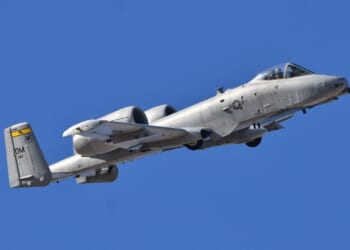Estonia lacks fighter aircraft and, along with Latvia and Lithuania, relies on other NATO members, including the UK, to carry out air policing duties.
During the Cold War, the United States military deployed Jupiter missiles to Turkey, which was seen as a direct threat to Moscow due to its then-shared border with the Soviet Union. The Kremlin’s decision to retaliate by placing its own missiles in Cuba triggered the 1962 Cuban Missile Crisis, after which both nations agreed to pull missiles away from each other’s borders. Today, however, nuclear weapons could be based even closer to Russia’s largest cities, as NATO member Estonia announced that it would be prepared to host allied nuclear-capable aircraft on its borders—notably British F-35A Lightning fighters.
“I’m always open. The door is always open for allies,” Estonian Defense Minister Hanno Pevkur said on Monday, the UK’s Telegraph newspaper first reported.
RAF Fighters Are Nuclear-Capable—but Might Not Be Nuclear-Armed
In June, the Royal Air Force (RAF) announced it would operate a dozen Lockheed Martin F-35A fifth-generation stealth fighters, which could be deployed in NATO nuclear missions if necessary. The RAF is on track to receive 27 additional F-35s as part of the second phase of its current procurement plan, which includes the dozen conventional takeoff and landing (CTOL) variants, along with 15 additional F-35B models, the short takeoff and vertical landing (STOVL) models that can also operate from the Royal Navy’s Queen Elizabeth-class aircraft carriers.
Once the RAF receives the F-35A aircraft, designated the “Lightning” by the British military rather than Lightning II, it will mark the first time the UK’s air service has played a nuclear role since the retirement of the WE.177 gravity bomb in 1998. The nuclear-capable F-35s will be based at RAF Marham in eastern Britain.
The RAF will begin to receive the next tranche of F-35s beginning around 2030, and London has confirmed the multirole stealth fighters could be integrated into NATO’s Dual Capable Aircraft posture.
“In an era of radical uncertainty we can no longer take peace for granted,” said British Prime Minister Keir Starmer—acknowledging that the adoption of the aircraft was “the biggest strengthening of the UK’s nuclear posture in a generation.”
Although there has been no indication from the UK that any of the jets would be based in Estonia or anywhere else in the Baltics, the mere suggestion that Tallinn was open to the idea was swiftly condemned by Moscow.
Kremlin spokesperson Dmitry Peskov called the talk of the deployment of nuclear-capable aircraft in the region “an immediate danger.”
Estonia’s decision to welcome the deployment of nuclear-capable F-35s comes just days after Russian MiG-31 Foxhound aircraft violated Estonian airspace for 12 minutes, prompting a response from Italian F-35s that were part of the NATO Air Policing deployment.
Moscow has denied any such breach.
Estonia lacks fighter aircraft and, along with Latvia and Lithuania, relies on other NATO members, including the UK, to carry out air policing duties. Pevkur had previously said in June that Estonia would welcome hosting NATO aircraft able to carry nuclear weapons. Still, some in the British government have also cautioned that such a deployment might be seen “less as a deterrence, more as an agitator.”
Russia: Let’s Not Talk About Kaliningrad, Please
To date, NATO has not acknowledged ever basing any nuclear weapons in Estonia, but such weapons of mass destruction were likely present during the Cold War, when the Soviet Army positioned rocket brigades armed with the S-200 long-range ballistic missiles. Today, the three Baltic nations are sovereign states and strongly anti-Russian in their outlook. However, there is speculation that Russia continues to possess nuclear weapons in its Kaliningrad exclave on the Baltic Sea, bordering Lithuania and Poland.
Estonia dismantled many of the Soviet-era military facilities, including nuclear-related infrastructure, at the end of the Cold War. It should be noted that, given the Baltic States’ inclusion in the Soviet network of defense forces and early warning systems, Estonia was considered a legitimate target in the event of a first strike by NATO against the Soviet Union.
Now the exact locations that were in NATO’s crosshairs could be where some of the alliance’s nuclear-capable weapons may be based in the not-too-distant future.
About the Author: Peter Suciu
Peter Suciu has contributed over 3,200 published pieces to more than four dozen magazines and websites over a 30-year career in journalism. He regularly writes about military hardware, firearms history, cybersecurity, politics, and international affairs. Peter is also a contributing writer for Forbes and Clearance Jobs. He is based in Michigan. You can follow him on Twitter: @PeterSuciu. You can email the author: [email protected].
Image: Shutterstock / Wirestock Creators.
















